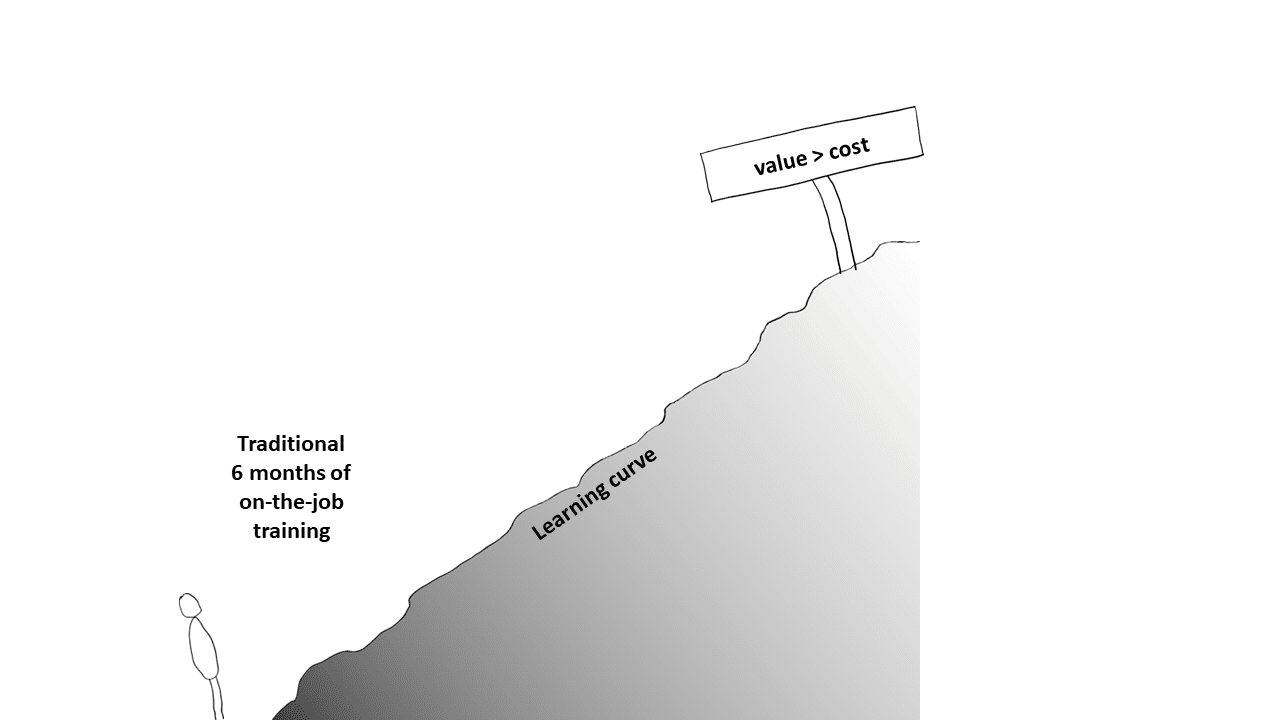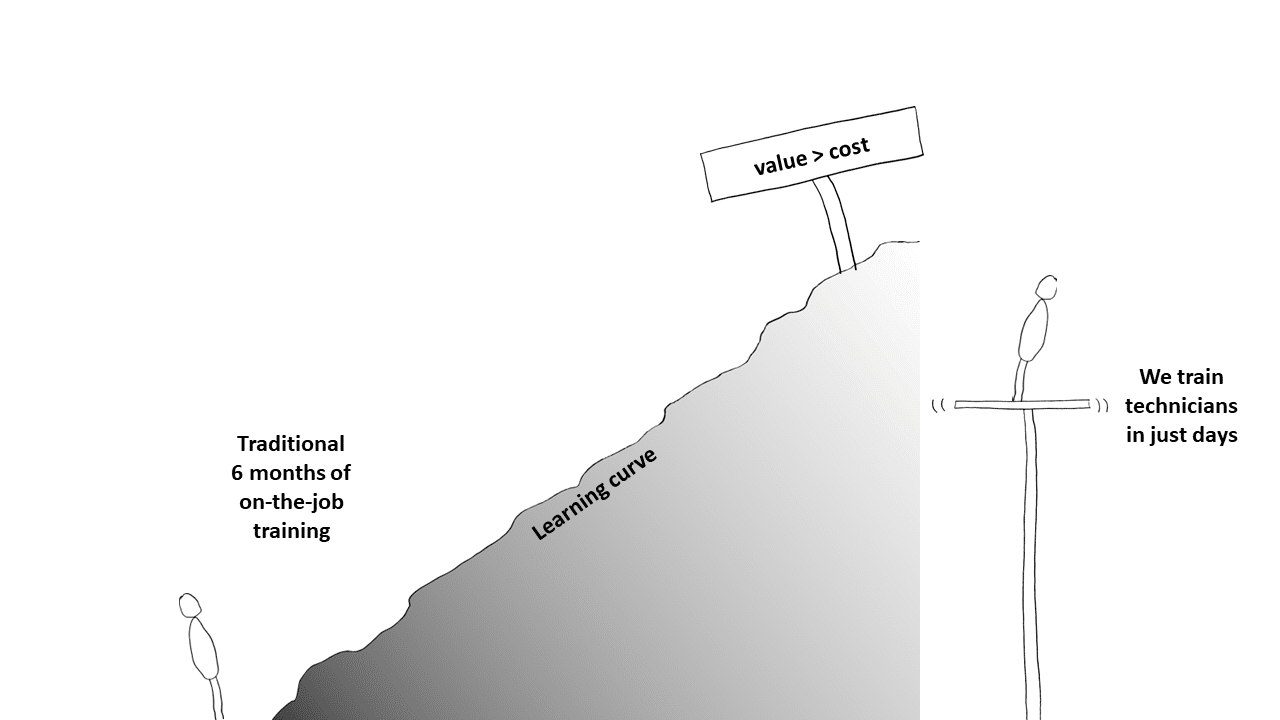About Field Sim Training
Field Sim Training is focused on making people amazing at their jobs, with an emphasis on folks who work in the field in the low voltage skilled trades, such as security, fire alarm, building automation, industrial automation, audio/visual, etc.
We offer online and in-person training. To enhance student learning, we have developed numerous resources, like the FS-24-TBS Troubleshooting Station used in our Troubleshooting and Meter Skills class.
The Problem
The skilled trades are facing historic labor shortages. Older workers are retiring and companies have been under-investing in talent for decades. ABC News in Austin recently interviewed businesses that are turning down jobs because they can't find enough skilled workers.
The good news is that people are always looking for a more rewarding career. Pew Research highlights the top reasons that people are leaving their job as 1) low pay and 2) no opportunities for advancement.
A career in the skilled trades is a great choice. Skilled trade jobs are often high-paying. Glassdoor puts the median skilled trades salary at $83,648/yr. In his excellent book, Drive, author Dan Pink explains what motivates people: autonomy in how they do their job, work that requires mastery and the opportunity to do work that makes a difference. He just described a career in the skilled trades.
Unfortunately, it's hard to get a job in the skilled trades if you don't already have the skills and experience.
Existing Solutions
There are numerous companies and other organizations providing training for folks working in the skilled trades. For the big MEP trades, there are training opportunities from both unions and open-shop industry associations. There are even well-respected training programs through two and four-year trade schools. The path from Apprentice to Journeyman or Master Electrician is clear cut and well-traveled, with generations of electricians who have followed that path.
For lower tier contractors like security, fire alarm, building automation, A/V, and other low voltage specialty subs, the training landscape is vastly different.
New technician training in these smaller industries is more ad hoc with the employer providing most of the training in-house and often informally. There are no comprehensive training programs from unions or industry associations that will safely guide an apprentice to master their trade.
The most common method for training a "green" employee at these companies is to pair them with another technician. This method takes six months before they can add meaningful value. At $15/hr, that's a burdened cost of around $25,000 to train someone new. This also loads additional responsibilities onto senior techs who are already overextended.
That's not to say that these more niche trades don't have external training resources available. There are many companies and associations that offer training. However, that training is woefully inadequate for teaching the practical skills needed by the folks in the field doing the actual work. Instead, the available training tends to be one of three kinds:
- Product training. Often provided by the manufacturer, this type of training focuses on the details of how to install, program, and maintain their equipment. The goal is to make it easier for their customers (or the installation side of their own company) to sell a lot more product.
- Licensing training. This type of training abounds. There are numerous companies who want to help technicians pass a test and get a license or certification. The focus is on rules and concepts. Examples range from PMP certifications to state security licenses to NICET fire alarm certifications. These classes are successful at what they set out to do. Most students go on to pass their test, which is often a requirement to do business or get a promotion - possibly one that allows them to spend less time climbing a ladder.
- Seminars. This category is sneaky. Recognizing the gap between someone that is new on the job and someone that is ready to take a test or program a system, trainers sometimes put together a course that they claim will teach the basics and they target this at newer techs. The problem is that they rarely move beyond offering a seminar-style overview. The curse of PowerPoint strikes again. Unable to produce training that isn't delivered via a structured slide, these trainers pursue a worthwhile goal using a medium that is wholly insufficient for the task. This is the biggest waste of money and often discourages managers from investing in formal training for future greenhorns.
Our Solution
Field Sim students learn practical skills for working in the field. We teach codes and rules where appropriate, but...
Our goal is far higher than just teaching someone how to pass a test. We want our students to be amazing at their job!
This goal orients our approach to designing training and results in a focused collection of topics that we teach.
When writing curriculum, we imagine we're explaining it one-on-one with the student. Or more likely, we recall how we've actually explained it to students in the past.
Our on-demand training is like no other training you've seen before. If you're used to online training that could have been a PDF or an email, prepare to be amazed. Instead of the PowerPoint approach that everyone else uses, each web-based course consists of a series of 4K videos. Instead of traditional instruction design, we write screenplays, draw storyboards, and sit down for table reads. The result is something more like professionally produced YouTube videos.
Again, these training videos are practical. We show how to do everything from roughing in electrical boxes to trimming out devices. Many scenes are filmed on jobsites instead of in the studio. And many scenes are filmed multiple times with multiple cameras. We want to show things at different angles. We'll switch out lenses to get a macro view when needed. This all takes time (a lot of time), but the results are worth it. Go sit through a seminar or a webinar or any other training class and then watch our videos. You'll immediately notice the difference. To make it easy, here's a free sample.
We also offer instructor-led training. Our founder, Ben Adams (more about him below), has been teaching for many years and now travels full-time, conducting in-person training.
The risk that a newly trained person will leave after getting trained is too great for many companies to take the chance. Instead, they bid up the wages of the few experienced people who are willing to jump ship or aren't currently employed for some reason. And they increase the workload for their existing employees. Or they turn down jobs, walking away from the ability to provide growth opportunities for their employees and shrinking the profits they can deliver.
With Field Sim training, companies can accelerate the time to value for new employees. The risk of hiring an inexperienced tech is diminished. The talent pool is larger. You can quickly staff up when you get a sudden increase in workload.
This isn't just for new techs. By investing in practical training for current employees, companies raise productivity, boost the bottom line, and increase retention. Plus customers love it when your people show up at their site and know what they're doing.
How to Access Training
There are several ways to access Field Sim training.
For a list of upcoming in-person courses, check out our Courses page. You can pick a class and complete the registration and payment form. Then you or your techs just need to show up at the prescribed location on training day.
If your company or organization has a learning management system (LMS), you can upload our on-demand courses so your staff can access them internally on your own platform. This is available on a per-student per-course pay-as-you-go model.
You can also purchase our web-based training directly on this site. Courses are available individually with a 30-day license. Some courses are also offered in bundles, which offer access for 12 months. If you purchase bundle licenses for your team, each license clock starts when the license is assigned to a student. That way you can take advantage of bulk pricing even if you don't need all the licenses today and you don't have to worry about using all the licenses within a year.
Ben is a sought-after author and presenter. He has presented at numerous national and regional conferences for organizations such as NFPA, AFAA, SFPE, TFMA, BPI, LLSSA, and others. He writes a regular column, Fire Alarm 411, for Security Business Magazine, where he explains core fire alarm concepts in a straightforward style.
Ben Adams left a GM role at Siemens and founded Field Sim in 2020 to develop hands-on training aids that simulate real-world systems and to teach practical skills to technicians, city inspectors, and others who work in the field.
Ben's career in the building technologies industry dates back to 1996. He has held increasing roles of responsibility, including service tech, project manager, system designer, regional sales manager, division manager, branch manager, and general manager.
During this tenure, Ben has performed nearly every job in the building technology industry, including finance, product management, software engineering, hardware engineering, project estimating, sales, system design, field installation, final commissioning, inspection, maintenance, troubleshooting, and managing managers.
Ben received his BBA in Finance from UTA and his MBA from TCU. He has achieved the highest level of engineering technician certification, NICET Level IV and is licensed to certify fire alarm and special hazards engineering drawings in the State of Texas.
For several years in the 2010s, Ben worked as an adjunct instructor teaching a 4-credit hour (full semester) class in the evenings at Dallas College. He is an NCCER certified instructor.
In 2000, Ben began a parallel career in software development when he took on a role as full-stack software developer with sole responsibility for creating the software for a startup in Sydney, Australia, that was chartered with bringing in 2,000 temporary workers from 50 countries for the Olympic Games. Since then, Ben has developed software at every company where he has worked, including deploying numerous applications to branches in the US and Canada for Siemens.
From 2022 to 2024, Ben took on an urgent role at Resideo (formerly Honeywell Home) where he led global software platform development. One of the top priorities was building a new event processing system in the wake of challenges with a legacy alarm delivery service that led to changes in the NFPA 72 and UL standards.
Ben's passion for software and lofty goals for delighting customers led him to study user experience design (UX) and make it core to his approach when creating software. This has had a noticeable impact on how he approaches curriculum development.
Giving back to the industry has been a long-time core value. From 2010 to 2016, Ben served on the North Central Texas Council of Governments Fire Advisory Board. He currently serves on a technical committee for UL.
Links
LinkedIn: https://linkedin.com/in/benadams1
Past Security Business Magazine Fire Alarm 411 columns: https://www.securityinfowatch.com/alarms-monitoring/fire-life-safety/contact/53073292/ben-adams



